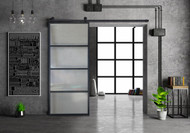A Guide to Interior Design Styles: Bauhaus Design
Dec 8th 2020
The Bauhaus design style is named after the Bauhaus, an art and design school founded in the Weimar Republic (modern-day Germany) in 1919. The school itself only existed for a little over a decade, but its impacts have been felt in the interior design space for over a century.
The design school encouraged students to treat functional items — from chairs to teapots — with the same care as fine art. In fact, Walter Gropius, the school’s founder, wrote a manifesto arguing that art and craftsmanship ought not to be separated at all. The design movement also focused on simplicity of form, material quality, and utility.
Interested in implementing Bauhaus elements in the décor of your home? (After all, who doesn’t want every item in their home to look like art?) Here are a few key elements to keep in mind.
Geometric Shapes and Clean Lines
Similar to minimalism’s focus on the light and space left behind once clutter is removed, the Bauhaus movement removes ornamentation to reveal the beauty of strong form. To this end, one of the visual hallmarks of the Bauhaus design is clean lines and geometric shapes.
To embody Bauhaus ideals in your home, look for décor that forgoes ornamentation and complicated textures or shapes. Bonus points for items that use the “simple shapes,” which are triangles, circles, and squares. Don’t be afraid to choose items with bold lines that make an impact upon the space.
Simple Colors
Bauhaus design favored the natural color of materials. When color was added, it was usually in bold primary colors — a bright blue, yellow, or red — to avoid unnecessary complication.
It may seem counterintuitive to have objects in the muted natural colors of their materials alongside objects treated with a bright primary color, but this actually fits well within the Bauhaus philosophy. When color is added, it should be purposefully done and meaningfully add to the form of the object.
To this end, look for interior design elements that either use untreated materials or that only add primary colors. Choose color for items that you want to highlight within your space. For example, it may make sense to make a table used for crafting or drawing the focal point of your workspace. A bright red tabletop could be the one pop of color the room needs.
By limiting color use to occasional splashes of bright color, you can create a high contrast room that draws the eye to the most important places in your home.
Basic Materials
Objects designed within Bauhaus were traditionally created using only glass, leather, steel, and concrete. While items inspired by the Bauhaus tradition may include additional materials, making frequent use of these materials harkens to this strict sensibility.
This is also part of the reason why Bauhaus sensibilities work well in tandem with industrial design. Items made out of strong, sensible materials in neutral colors are always welcome within the Bauhaus aesthetic.
To try this in your home, look for items made of high-quality, simple materials. In general, the fewer and less treated the materials, the better. Avoid plastics and particle board, opting for metal and solid wood options instead.
Utility
To keep with the Bauhaus spirit in your home, the objects you buy should be designed use in mind. Every part of the object should serve a purpose — no unnecessary swooshes or embellishments that could throw off the beauty of a simple form.
Bauhaus design is all about refusing to compromise on form or function, instead finding a balance between the two. Items you use every day should work seamlessly and look like art. As such, actually selecting the objects to fill your home with is one of the biggest challenges of attempting a Bauhaus aesthetic.
Luckily, the search for the perfect door doesn’t have to be difficult. BarnDoorz.com has a door that keeps all of these design elements in mind: the Fleetwood Modern Barn Door. The door is engraved with clean lines, adding a strong form where many doors’ complicated panels would take away from the Bauhaus look. In addition, the door is made of solid wood, keeping with the Bauhaus preference for quality material.
Highly customizable, the Fleetwood Modern Barn Door includes an unfinished option that reveals the beauty of the natural wood. You can also choose a simple steel handle and rolling hardware to further add to the aesthetic. In addition, rolling barn doors create an ease of use that is very in line with Bauhaus sensibilities.
BarnDoorz.com is here to help you create the perfect Bauhaus-inspired interior. Give us a call at 713-400-6626 to talk about your sliding door options.
